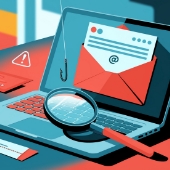Watch out: Cybercriminals can use your office devices to phish for information
 Hackers have found a way to send phishing emails using regular office devices such as printers, bypassing security checks. Read this article to learn how this scheme works and the steps you can take to prevent an attack.
Hackers have found a way to send phishing emails using regular office devices such as printers, bypassing security checks. Read this article to learn how this scheme works and the steps you can take to prevent an attack.
How do hackers use office devices to send fake phishing emails?
Microsoft 365’s Direct Send feature was originally designed to simplify internal email communication within organizations. However, hackers have discovered a way to use it to send phishing messages that appear to have come from within the company, all without ever accessing a single email account.
Because these messages are disguised as internal communications, they can easily bypass security filters that typically block suspicious messages. Also, these emails often mimic normal document alerts or voicemail notifications, so they appear trustworthy to employees. Since employees are used to receiving such emails, they are more likely to open them without hesitation. Once a link is clicked or an attachment is opened, hackers can steal personal information, capture login credentials, or install harmful software on your network.
Why office devices are the perfect tool for cybercriminals
While printers and other office devices are often used in handling documents with sensitive information, they are often overlooked in security plans, creating a vulnerability that hackers are eager to exploit. Without robust security measures in place, printers, scanners, and smart office equipment can become gateways for phishing schemes and other malicious activities.
Tips to protect your business against phishing
Safeguarding your organization requires integrating all office devices into your cybersecurity strategy. This means ensuring they are regularly updated, securely configured, and continuously monitored for potential vulnerabilities. You can start with the following steps:
- Check your email settings: Make sure your email system is equipped with robust security measures to guard against fraudulent emails, including tools that verify authentication and detect spoofing.
- Consider all devices equally important: Keep an eye on printers, scanners, and other network-connected devices, as they are potential targets for hackers. Patch security updates as soon as they become available, and observe printers, scanners, and fax machines for any unusual beeping, flashing lights, or printing.
- Train your employees: Train your staff to identify suspicious emails, particularly those that appear to come from within the company. Additionally, make it mandatory to double-check any email that asks for sensitive information.
- Monitor email activity: Watch out for unusual email activity, such as messages being sent from strange devices or to unusual places. Setting up alerts for abnormal behaviors can help catch issues early.
The bottom line: Staying proactive and vigilant is key
Cybercriminals will try to take advantage of any potential access point to your system. A good rule to remember is that if a device is connected to your network, it is automatically a potential weakness.
For more help with securing your organization against phishing attacks and other cybersecurity threats, reach out to our IT team today.
 A new security flaw in Microsoft 365 enables hackers to exploit office devices and send fake emails that appear to be from within an organization. Let’s look at how this scam works and what you can do to keep your data protected.
A new security flaw in Microsoft 365 enables hackers to exploit office devices and send fake emails that appear to be from within an organization. Let’s look at how this scam works and what you can do to keep your data protected. Cybercriminals are now using innocuous office devices such as printers and scanners to launch phishing attacks without needing to hack into your email account. Learn how to spot and stop this new trick to keep your workplace safe from phishing scams.
Cybercriminals are now using innocuous office devices such as printers and scanners to launch phishing attacks without needing to hack into your email account. Learn how to spot and stop this new trick to keep your workplace safe from phishing scams. Cyberthreats are everywhere, and Macs are common targets. To keep your device and data safe, you need to choose the right anti-malware software. In this quick guide, we walk you through the most important features of antivirus solutions and provide recommendations on the top software options for 2025.
Cyberthreats are everywhere, and Macs are common targets. To keep your device and data safe, you need to choose the right anti-malware software. In this quick guide, we walk you through the most important features of antivirus solutions and provide recommendations on the top software options for 2025. Protecting your Mac from malware, such as viruses, Trojans, worms, ransomware and spyware is essential for maintaining the security and privacy of your data. This article explores why Macs face increasing risks and how the right anti-malware software can keep your data and online activities safe.
Protecting your Mac from malware, such as viruses, Trojans, worms, ransomware and spyware is essential for maintaining the security and privacy of your data. This article explores why Macs face increasing risks and how the right anti-malware software can keep your data and online activities safe. It’s a common misconception that Macs are more secure devices than PCs, but the reality is far different. Malicious programs, or malware, are becoming so much more sophisticated, evasive, and dangerous that even Macs are vulnerable. To protect your device and personal information, it’s crucial to have anti-malware software.
It’s a common misconception that Macs are more secure devices than PCs, but the reality is far different. Malicious programs, or malware, are becoming so much more sophisticated, evasive, and dangerous that even Macs are vulnerable. To protect your device and personal information, it’s crucial to have anti-malware software. While VoIP systems offer businesses a range of benefits, they also attract thieves looking to exploit vulnerabilities in the system. One way they do this is through VoIP theft of service, which can cause significant harm, from financial loss to reputational damage. This article discusses practical steps to secure your communication system and prevent these types of attacks.
While VoIP systems offer businesses a range of benefits, they also attract thieves looking to exploit vulnerabilities in the system. One way they do this is through VoIP theft of service, which can cause significant harm, from financial loss to reputational damage. This article discusses practical steps to secure your communication system and prevent these types of attacks. The rise of VoIP technology has significantly lowered communication costs, but it has also introduced a new form of cybercrime: theft of service. This threat enables cybercriminals to infiltrate systems and cause severe operational and financial damage. This is why it pays to prioritize securing your VoIP infrastructure and monitoring for suspicious activity. Read on to learn more.
The rise of VoIP technology has significantly lowered communication costs, but it has also introduced a new form of cybercrime: theft of service. This threat enables cybercriminals to infiltrate systems and cause severe operational and financial damage. This is why it pays to prioritize securing your VoIP infrastructure and monitoring for suspicious activity. Read on to learn more. VoIP systems offer businesses an affordable and efficient way to stay connected. Alarmingly, the risk of VoIP theft is growing as attackers hijack services and threaten business operations. Understanding this threat and how to protect your network is crucial for avoiding costly disruptions.
VoIP systems offer businesses an affordable and efficient way to stay connected. Alarmingly, the risk of VoIP theft is growing as attackers hijack services and threaten business operations. Understanding this threat and how to protect your network is crucial for avoiding costly disruptions. The global CrowdStrike outage in July 2024 served as a stark reminder of the fragility of our digital infrastructure. In response, Microsoft is undertaking a fundamental reinvention of its operating system with the Windows Resiliency Initiative. It’s a strategic overhaul designed to make sure Windows can withstand crises of similar scale and impact in the future.
The global CrowdStrike outage in July 2024 served as a stark reminder of the fragility of our digital infrastructure. In response, Microsoft is undertaking a fundamental reinvention of its operating system with the Windows Resiliency Initiative. It’s a strategic overhaul designed to make sure Windows can withstand crises of similar scale and impact in the future.